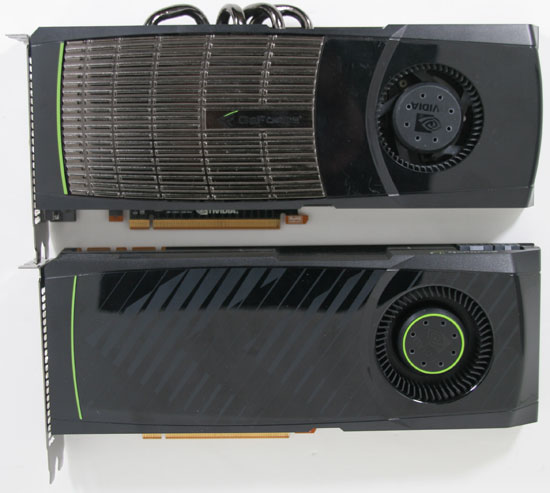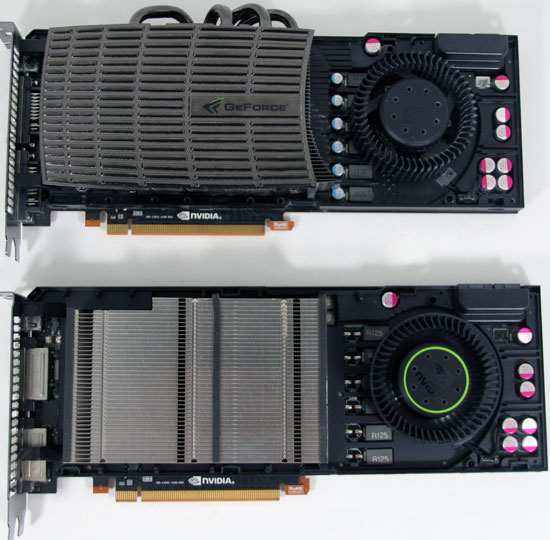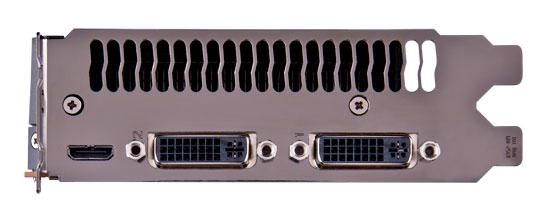NVIDIA's GeForce GTX 580: Fermi Refined
by Ryan Smith on November 9, 2010 9:00 AM ESTMeet the GTX 580
Since we’ve already discussed the cooling, let’s dive right in to the rest of the GTX 580, shall we?
Launching today will be a single GTX 580 design, the reference design. Talking to our contacts, semi-custom designs (designs using the reference PCB with a different cooler) are due in the next few weeks assuming everything goes to plan and of course there’s ample supply. And while we’re on that note, NVIDIA let us know that with their focus on cooling on the GTX 580 they aren’t going to be letting custom GTX 580 designs go out without a more thorough inspection. The acoustic performance of the reference GTX 580 is going to be the bare minimum to get a design approved – if it can’t beat the reference design, NVIDIA won’t allow it. We consider this a matter of brand protection for the company, as a bad/loud GeForce is still a GeForce all the same.

Top: GTX 480. Bottom: GTX580
With the reference design the resulting card is very close to being a GTX 285/480 hybrid. In terms of overall design it ends up looking very similar to the GTX 285. At 10.5” long it’s the same length as the GTX 480 or a smidge longer than the GTX 285, and should fit in to any cases those cards could work in. Power connectivity is the same as the GTX 480, with 6pin and 8pin PCIe sockets being located at the top of the card, providing easy access to the sockets. At 244W TDP the card draws too much for 6+6, but you can count on an eventual GTX 570 to fill that niche. Meanwhile NVIDIA has kept the 480’s detachable shroud lid, meaning you can remove the cover of the shroud without disturbing the rest of the card; it’s worth noting that it’s secured with screws rather than laches this time however.

Heatsinks Exposed! Top: GTX 480. Bottom: GTX 580
On the front side of the PCB you’ll find the 12 GDDR5 chips composing the card’s 384bit memory bus. The thermal pads connecting the memory to the shroud have once again wiped out the chip markings, so we haven’t been able to determine what these chips are, although we’re confident they’re 5Gbps like in past cards. At the center of the card is the GF110 GPU encased in a metal heatspreader, a common sight for NVIDIA’s high-end GPUs. This is an A1 revision GPU, which in NVIDIA’s counting system means it’s the first tape-out. Elsewhere on the board you’ll find the 2 SLI connectors, providing support for tri-SLI on the 580. All told while the GPU has been refined, the PCB remains largely unchanged from the GTX 480 other than removing the ventilation holes – all of the ICs are in practically the same place, and even the VRM controller is the same.
Meanwhile looking at the IO bracket for the 580, we find the same configuration as we saw on the 480. Below a full-sized vent are 2 DVI ports and a mini-HDMI port. NVIDIA slightly revised their display controller for GF110/GTX580; the good news is that HDMI 1.4a is supported, the bad news is that full audio bitstreaming is not supported so it’s the same as it was on the GTX 480: 8 channel LPCM and lossy audio formats like DD+ and DTS. This actually caught us off-guard since we were expecting the full GF104 treatment here, but it just goes to show that this is a GF100-derrivative after all. Unfortunately this also extends to the number of displays supported – NVIDIA still only supports 2 displays on one card, so you need to run in SLI if you intend to take advantage of 3DVision/NVIDIA surround across 3 monitors.

Finally, it’s with some sense of irony that we find ourselves yelling more at AMD than NVIDIA for naming shenanigans this time around, considering it was NVIDIA that brought us the 8800GT/9800GT and GeForce 200/300 product naming snafus. While NVIDIA has made some changes compared to the GTX 480, it’s a very short list; shorter than even AMD’s list for the 6800 series. At the same time, at least the GTX 580 is faster than the GTX 480 versus AMD’s 6800/5800 series. Quite frankly the GTX 580 should be the GTX 485 – the few architectural changes we’ve seen do make a difference, but then NVIDIA did a whole die shrink on the GTX 280 and only got a GTX 285 out of it. Both companies seem committed to coming out with a new family of video cards this year regardless of where the GPU powering them has actually changed. Ultimately the GTX 580 is the second flimsiest excuse for a new series number, next only to simply rebranding an existing GPU.











160 Comments
View All Comments
StevoLincolnite - Tuesday, November 9, 2010 - link
I would have called them the 6750/6770 personally... Or at the very least the 6830/6850.There were also some architectural changes in the GTX 580 as well.
slickr - Tuesday, November 9, 2010 - link
Whats real and whats not real for you?6850 and 6870 are essentially more shaders, rops and higher clocks with few architectural improvements.
It will be same for the 6900 series.
GTX 580 again is same as the above, few architectural improvements, higher shaders, textures and clocks.
Credit must be given where its due and even though this was supposed to be the 480, its still a great product by its own, its faster, cooler, quieter and less power hungry.
ninjaquick - Thursday, December 2, 2010 - link
Umm, 6850 and 6870 are DECREASES on all but ROPs and Clocks. The architecture is only similar and very much evolutionary:numbers are: Universal Shader : Texture Mapping Unit : Render Output unit.
5850: 1440:72:32
6850: 960:48:32
5870: 1600:80:32
6870: 1120:56:32
So, 5-10% slower and 33% component shrink, which is to say ~1.4x perf increase per shader. So a full blown (6970) NI at an assumed 1600 shaders like the previous gen would be the rough equivalent of a 2400 shader evergreen when it comes to raw performance, so 1.4 to 1.5 times faster. It can be safely assumed that the shader performance will be higher than 2 5830s in CFX. 2 5830s are about 30% faster than a GTX 580.
That is theoretical performance based on a lot of assumptions and Ideal drivers. My point is NI is not a ground up redesign but it is a vastly superior and vastly different architecture to Evergreen.
boe - Thursday, November 18, 2010 - link
I can't wait to see a comparison with the 6970. I don't know which will win but it will help me decide which to get - I'm still using a 4870 so I'm ready for something new!The other thing that will help me decide is card options. The 4870 had some very nice "pre-silenced" modified cards right after release. The 6870 already has some "pre-silenced" cards on the market. The factory standard 580 is pretty loud although it is quieter than the 480 by far. I'm hoping there will be some modified 580's on the market with much quieter but at least as effective cooling solutions.
Will Robinson - Tuesday, November 9, 2010 - link
This is a much better effort than GTX480.Cooler,quieter and faster.
AMD will have a tough fight on their hands with Cayman XT versus this new part.
StevoLincolnite - Tuesday, November 9, 2010 - link
Can't wait for a price war, something that seemed to be missing with Fermi and the 5xxx series.Sihastru - Tuesday, November 9, 2010 - link
Let's hope so. This way both fanbois camps will win when it comes to how much lighter their wallets will be after their purchase (in some cases their parents wallets - only children act like fanbois).B3an - Wednesday, November 10, 2010 - link
I -wish- only children acted like fanboys. The fact is that a lot of these guys are well into there 20's and 30's.They really are pathetic people.
mino - Tuesday, November 9, 2010 - link
Well not that it was hard to beat 480 ... that part was not ready for prime time in the first place.dragonsqrrl - Wednesday, March 18, 2015 - link
...lol, facepalm.